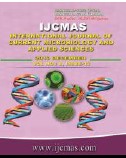


 National Academy of Agricultural Sciences (NAAS)
National Academy of Agricultural Sciences (NAAS)

|
PRINT ISSN : 2319-7692
Online ISSN : 2319-7706 Issues : 12 per year Publisher : Excellent Publishers Email : editorijcmas@gmail.com / submit@ijcmas.com Editor-in-chief: Dr.M.Prakash Index Copernicus ICV 2018: 95.39 NAAS RATING 2020: 5.38 |
Bovine fertility is affected by nutritional and non nutritional factors. The non nutritional factors include micro-climate of the stable, lay-out of the stable, hygiene and genetic manipulations. The most common cause of infertility in cattle is poor nutrition (Navarre et al., 2010). Minerals have a great impact on animal's reproductive physiology. Their imbalance causes various problems leading to lowered reproductive efficiency and resultant monetary loss to the dairy industry. Adequate micro minerals supplementation is required as most of the roughages, greens, concentrates and even most of commercial feeds available to Indian market are deficient in trace mineral elements. Often, correcting an imbalance in mineral levels can solve the nagging problem of infertility by improving reproductive performance and health with little additional cost (Kumar et al., 2011). The main source of vitamin A for ruminants is B-carotene which is available in abundant quantities from green foliage. In the intestinal mucosa, B-carotene is converted to vitamin A. The importance of B-carotene had been viewed solely as a source of vitamin A until 1955. Since then, stabilized vitamin A has become available for use in animal feeds and research has extended into the comparison between vitamin A and B-carotene. It was not until the 1970s that B-carotene was suspected to have effects independent of its role as a vitamin A precursor in bovine reproduction. The present study shows total 24 infertile crossbred cows were selected to induce oestrus taken for correction of an oestrosity with β-carotene incorporated vitamin-permix. Total 8 out of 24 animals exhibited oestrus symptom after the treatment. Among the animals received β-carotene incorporated vitamin-permix (treatment group) 50% showed the oestrus symptoms. Among the animals under control 16.66% came into heat.
 |
 |
 |
 |
 |